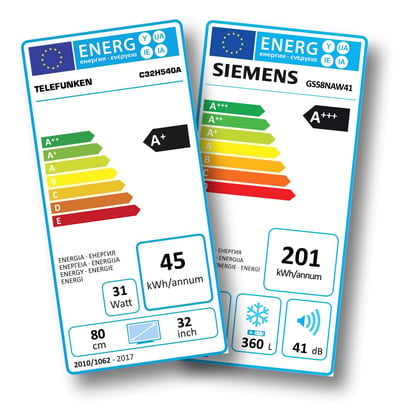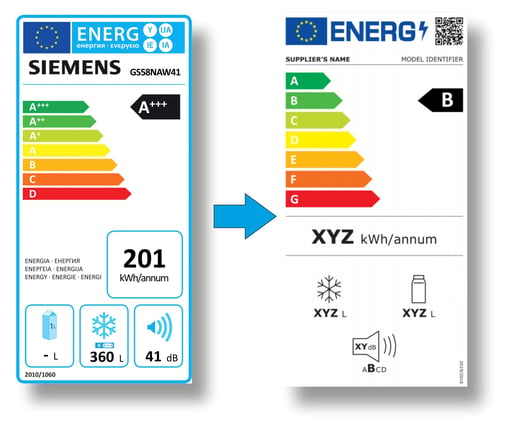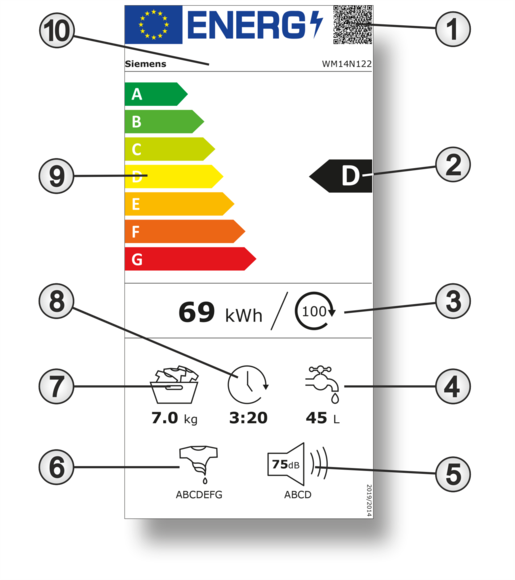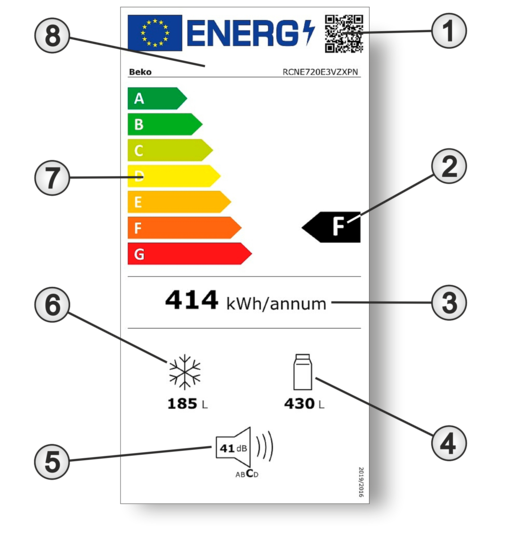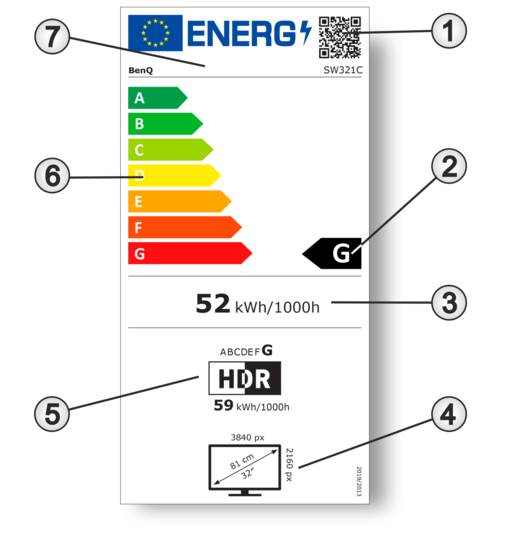Energy efficiency classes explained simply » Conversion of energy consumption labeling to A to G
Published: 31.05.2023 | Reading time: 8 minutes
This text is machine translated.
Energy labels are an extremely consumer-friendly invention. Because if there are several products to choose from in a store or online store, prospective buyers can immediately see which electrical appliance is the most economical in its use of precious energy.
You don't necessarily have to know exactly which value is hidden behind the colored gradations. However, everyone has a feeling that the color green is better than yellow and much better than red in terms of energy efficiency. After all, the traffic lights at road junctions also work with these colors. Unfortunately, however, the system and the specified test conditions are now outdated. It was therefore high time for the European Union to update the EU directive on energy consumption labeling to the latest state of the art.
The EU energy label or energy consumption label was introduced back in 1994. It was based on the American grading system. Appliances with a low energy requirement were assigned to energy efficiency class (EEK) A. Appliances with a high energy requirement were assigned class G. The allocation from class A to class G was based on a direct comparison with a fictitious standard defined at the time. As a result of technical developments and legal requirements, more and more appliances achieved efficiency class A.
However, to make the difference in consumption values clearly visible, the energy efficiency classes A+ and A++ were added to refrigerators as early as 2003. In 2011, the energy efficiency classes for washing machines, dishwashers and televisions were then also extended to A+, A++ and A+++. In this context, the energy efficiency class A+++ was also introduced for refrigerators.
Manufacturers have recognized energy efficiency and the associated reduction in power consumption and CO2 emissions as a selling point for their products. As a result, appliances were continuously developed to make them more and more economical. This has inevitably meant that the current efficiency classes are no longer sufficient. In addition, prospective buyers have the impression that all appliances have a very low energy consumption of class A and only differ by the different number of plus signs.
This means that the actual purpose of clear energy consumption labeling for new appliances is no longer fulfilled. As the introduction of further plus classes would be more confusing than helpful, the EU Commission has introduced new energy labels for some product groups across Europe, which have been in force since March 1, 2021.
In the new EU energy label, the assessment criteria for classification have been changed and adapted to the current state of the art. To ensure that there is enough room for improvement, the assessment criteria of the new energy label are so strict that the most economical electrical appliances at present are only classified in the new class B or C. However, the color gradations from red to yellow to green have remained the same. What has remained the same, however, are the color gradations from red to yellow to green. However, there are no additional plus signs for class A and the gradations now range from A-G.
The individual energy efficiency classes (EEK) partly describe the relationship between the actual weighted energy consumption and the fictitious energy consumption in the newly defined standard cycle. There is also a QR code in the top right-hand corner of the new EU energy label. This can be used to retrieve the current label data and additional appliance information from a central EU database (EPREL = European Product Database For Energy Labeling).
As there are also different assessment criteria in the different appliance classes, the EU energy labels also differ. For this reason, we would like to take a closer look at the energy labels that have been in force since March 1, 2021. The new energy consumption labels apply to electronic displays including televisions and monitors, dishwashers, refrigerators and freezers as well as washing machines and washer-dryers.
However, it is not just about electrical power consumption. Noise emissions, e.g. for refrigerators, also play an important role. For household appliances such as washing machines and dishwashers, the load volume, water consumption, residual moisture and time required per cycle are also important. All of this information is clearly displayed on the respective label in accordance with the EU Directive.
Energy label for washing machines
Washing machines are assigned to an energy efficiency class in the “Eco 40 - 60” washing program.
-
The QR code can be used to query further information about the device in the EPREL database.
-
Indication of the new EU energy efficiency class.
-
Weighted energy consumption for 100 wash cycles in the “Eco 40 - 60” program.
-
Weighted water consumption per wash cycle in the “Eco 40 - 60” program.
-
Noise emission during the spin cycle in the “Eco 40 - 60” program in decibels dB(A) and the corresponding noise emission class.
-
Residual moisture with spin efficiency class (A for low residual moisture and G for high residual moisture).
-
Information on the maximum fill quantity for the “Eco 40 - 60” program.
-
Informationen über die maximale Füllmenge für das Programm „Eco 40 - 60“.
-
Energy efficiency class A - G.
-
Name or trademark of the supplier with type designation of the device.
Energy label for washer dryers
In contrast to washing machines, the energy label for washer-dryers is split into two parts. This is because many people do not run a washer-dryer through its entire program. Only the washing machine function is then used. The left-hand section shows the data for the washing and drying function and the right-hand section shows the data when only the washing function is used. The classification into an energy efficiency class takes place in the “Eco 40 - 60” program.
-
The QR code can be used to query further information about the device in the EPREL database.
-
Indication of the new EU energy efficiency class (wash right, wash and dry inside out).
-
Weighted energy consumption for 100 wash cycles in the “Eco 40 - 60” program (wash right, wash left and dry).
-
Weighted water consumption per wash cycle in the “Eco 40 - 60” program (wash right, wash left and dry).
-
Noise emission during the spin cycle in the “Eco 40 - 60” program in decibels dB(A) and the corresponding noise emission class.
-
Residual moisture with spin efficiency class (A for low residual moisture and G for high residual moisture).
-
Time specification for the duration of the “Eco 40 - 60” program (wash right, wash left and dry).
-
Information on the maximum load quantity for the “Eco 40 - 60” program (wash right, wash and dry left).
-
Energy efficiency class A - G.
-
Name or trademark of the supplier with type designation of the device.
Note:
The energy label for tumble dryers has not yet been updated and there is currently (as of May 2023) no fixed date for this.
Energy label for dishwashers
For dishwashers, the classification into an energy efficiency class is carried out in the “Eco program”.
-
The QR code can be used to query further information about the device in the EPREL database.
-
Indication of the new EU energy efficiency class.
-
Weighted energy consumption for 100 cleaning processes in the “Eco program”.
-
Weighted water consumption per cleaning process in the “Eco program”.
-
Noise emission in the “Eco program” in decibels dB(A) and the corresponding noise emission class.
-
Time specification for the duration of the “Eco program”.
-
Number of place settings that fit in the dishwasher.
-
Energy efficiency class A - G.
-
Name or trademark of the supplier with type designation of the device.
Energy label for fridges and freezers
Other important parameters are taken into account in the new test procedure when classifying refrigerators or freezers into an energy efficiency class. These include factors such as room temperature, operating principle and the number or size of storage compartments included.
-
The QR code can be used to query further information about the device in the EPREL database.
-
Indication of the new EU energy efficiency class.
-
Weighted energy consumption per year.
-
Useful capacity of the available cooling and fresh food compartments (in liters).
-
Noise emission in decibels dB(A) and the corresponding noise emission class.
-
Useful capacity of the available freezer compartments (in liters).
-
Energy efficiency class A - G.
-
Name or trademark of the supplier with type designation of the device.
Energy label for televisions, monitors and award displays
For televisions, monitors and displays, the new EU energy label now indicates two consumption values.
The first value corresponds to the energy consumption at standard settings for dynamic range and contrast (Standard Dynamic Range). The second value corresponds to the energy consumption with a high dynamic and contrast range (High Dynamic Range).
-
The QR code can be used to query further information about the device in the EPREL database.
-
Indication of the new EU energy efficiency class.
-
Weighted energy consumption per 1000 hours at Standard Dynamic Range.
-
Visible screen diagonal and horizontal and vertical resolution in pixels.
-
Weighted energy consumption per 1000 hours at High Dynamic Range.
-
Energy efficiency class A - G.
-
Name or trademark of the supplier with type designation of the device.
Energy label for light sources
The new energy labels - and therefore also the new energy efficiency class for light sources - have been valid since September 1, 2021. Another new feature is that external power supply units are now also included in the calculation of power consumption.
An LED light with 7 W can therefore have an energy requirement of 8 kW per 1000 operating hours. This is because, due to the external power supply unit, the illuminant output of 7 W is multiplied by a factor of 1.1 and then rounded to the nearest whole number. The label is available in two sizes.
-
Indication of the new EU energy efficiency class.
-
Weighted energy consumption per 1000 operating hours when switched on.
-
The QR code can be used to query further information on the light source in the EPREL database.
-
Energy efficiency class A - G.
-
Name or trademark of the supplier with type designation of the product.
When purchasing a new fridge, fridge-freezer, washing machine or tumble dryer, many factors are important when making a purchase decision.
In addition to size, capacity and ease of use, great importance should also be attached to an energy-saving appliance with a good energy efficiency class. Even if these models often have a higher price, which is also a not insignificant factor in the purchase decision.
However, it is worth taking a closer look at the energy label and calculating the annual power consumption. Because the lower operating costs of an economical appliance mean that the higher purchase price is amortized after a relatively short time.
If the entire operating period is considered, the household budget and the environment benefit in equal measure. And this is precisely why the new energy efficiency classes were defined by the EU Commission.
From what date do the new EU energy labels apply?
The new EU energy labels for electronic displays including televisions and monitors, dishwashers, fridge-freezers and washing machines will apply from March 1, 2021, and for light sources from September 1, 2021. New energy labels are in preparation for other product groups, such as tumble dryers. There are currently (as of 8/2022) no fixed dates for this.
What does the energy efficiency class mean?
The energy efficiency class primarily indicates how economically a refrigerator, washing machine or other electrical appliance uses energy. However, it is not just about power consumption alone. In some cases, other important parameters such as water consumption, time requirements, filling quantities, noise levels and efficiency are also included in the overall result. These factors are then also shown on the energy label.
What is the purpose of the QR code on the energy label?
According to the EU regulation, manufacturers of energy-related products store further information and product data in a central database (EPREL). The consumer can scan the QR code using a smartphone and call up the information. This makes it easier to differentiate between the products in question when making a purchase decision.
Why are there hardly any appliances in a product group with the best energy efficiency class A?
The European Commission has decided to make the directive for the EU label more demanding. This was to prevent technical progress and more efficient appliances from overtaking the EU directive within a few years. For this reason, the criteria for classification into an energy efficiency class under the new energy label were defined so strictly that, for example, a refrigerator that had energy efficiency class A+++ under the old label now has class D or E under the new label. Due to the different assessment criteria, which have been adapted to the current state of the art, a direct comparison between an old label and the new energy labels is not possible.

